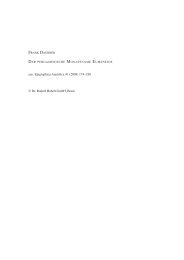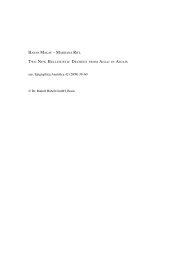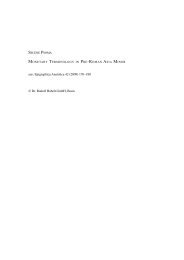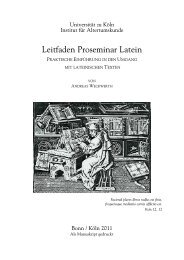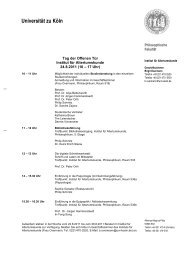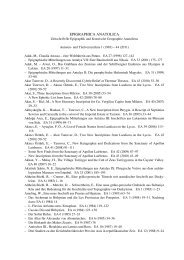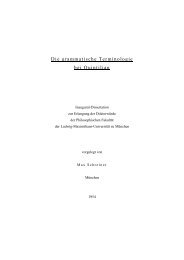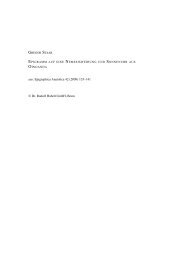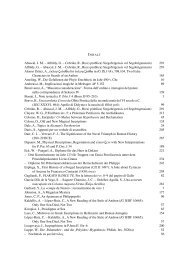You also want an ePaper? Increase the reach of your titles
YUMPU automatically turns print PDFs into web optimized ePapers that Google loves.
GLEN W. BOWERSOCK<br />
A NEW FUNERARY EPIGRAM FROM LAODICEA AD LYCUM<br />
aus: Epigraphica Anatolica 42 (2009) <strong>152</strong>–<strong>156</strong><br />
© Dr. Rudolf Habelt GmbH, Bonn
A NEW FUNERARY EPIGRAM FROM LAODICEA AD LYCUM<br />
For Alan Cameron 1<br />
In view of a hitherto unreported squeeze available to me I discuss here a relatively new but difficult<br />
metrical inscription. It is an undated funerary epigram from Laodicea on the Lycus River<br />
in Asia Minor. In the 1990s Thomas Corsten copied the inscription in Turkey and first published<br />
a provisional text and photograph of it in Arkeoloji Dergisi 3 (1995), 217–218, no. 2, with plate 55<br />
(image 3). It was republished by R. Merkelbach and J. Stauber in Steinepigramme aus dem griechischen<br />
Osten vol. 1 (1998), p. 272, no. 02/12/11 as now at Hierapolis (Pamukkale) in the collection<br />
of the Denizli Museum. The Fundort is given as unbekannt. Corsten’s text was reprinted<br />
as SEG 45. 1754, with a suggestion for a new reading at the end of the last line (more below). I<br />
would guess from the letter forms that the stone was cut in the late Hellenistic or early imperial<br />
periods, but certainty is impossible.<br />
The inscription appears as follows in Merkelbach–Stauber:<br />
Πανδαμάτωρ φιλόκαινε [<br />
τίπτε με ἑνδεχέτη παιδί[ον ?<br />
Ζώσιμον οὔνομ’· Ἄτα τὸν ἐν ἐκκλ.[<br />
4 ε ἰ ς Ἀΐδαν ἐρατὸν κοῦρον [e.g. ἐνοσφίσατο]<br />
ἤλπι ζον δ’ ἐπ’ ἐμοὶ γονέες ὑμέναι[ον ἀεῖσαι]<br />
οὐκ ἐπ’ ἐμοῖς θρήνοις τύμβον ἀνοικ[οδομεῖν.]<br />
χαίροι ς , ὦ παροδῖτα, καὶ ἄν τιν’ ἐπῶν πα[ραμείψαις]<br />
8 εἰς μέγα πλούτου ἵκοις γ ῆρας .E[.]ΕΥ[<br />
Mordliebender Allesbezwinger - - - wie konntest du mich 11jährigen Knaben - - - namens Zosimos.<br />
Das Verderben hat den - - - lieblichen Jungen in den Hades geführt. Meine Eltern hofften<br />
darauf, mir den Hochzeitsgesang zu singen, nicht zum Wehklagen über mich ein Grab zu erbauen.<br />
Wanderer sei gegrüsst, und wenn du mir mit einem freundlichen Wort antwortest, mögest du<br />
zu grossem Reichtum gelangen und hohes Alter erreichen.<br />
It happens that Jeanne and Louis Robert had taken an excellent squeeze of this inscription at<br />
Laodicea in 1962 when they were working on the inscriptions discovered by Canadian archaeologists<br />
from Laval University. The epigram was not one of the Laval finds. The Roberts’ squeeze<br />
is now in Princeton at the Institute for Advanced Study, among the many treasures given to the<br />
Institute by Jeanne Robert in 1992, seven years after her husband’s death. With the aid of this<br />
squeeze and reflections of my own I hope to illustrate what can be done with just one of the many<br />
metrical fragments from antiquity that come to light every year.<br />
I give here a diplomatic text based upon Louis Robert’s squeeze (fig. 1), now in Princeton:<br />
1<br />
These observations were originally presented to my friend of more than half a century at a symposium (6<br />
December 2008) at Columbia University’s Center for the Ancient Mediterranean on the occasion of his retirement.<br />
I chose this subject in recognition of his exceptional contributions to the study of Greek epigrams. In preparing<br />
these notes, I have once again profited from discussion with C. P. Jones.
A New Funerary Epigram from Laodicea ad Lycum 153<br />
ΠΑΝ. ΑΜΑΤΩΡΦΙΛΟΚΑΙΝΕ<br />
ΤΙΠΤΕΜΕΕΝΔΕΧΕΤΗΠΑΙΔΙ<br />
ΖΩΣΙΜΟΝΟΥΝΟΜΑΤΑΤΟΝΕΝΕΚΚΑ<br />
Ε.ΣΑΙΔΑΝΕΡΑΤΟΝΚΟΥΡΟΝ<br />
ΗΛΠΙΖΟΝΔΕΠΕΜΟΙΓΟΝΕΕΣΥΜΕΝΑΙ<br />
ΟΥΚΕΠΕΜΟΙΣΘΡΗΝΟΙΣΤΥΜΒΟΝΑΝΟΙΚ<br />
ΧΑΙ.ΟΙΣΩΠΑΡΟΔΙΤΑΚΑΙΑΝΤΙΝΕΠΩΝΠΑ<br />
ΕΙΣΜΕΓΑΠΛΟΥΤΟΥΙΚΟΙΣΓΗΡΑΣΕ.ΕΥΒ<br />
We may begin with the first line up to the break, Παν[δ]αμάτωρ φιλόκαινε, which Merkelbach–<br />
Stauber render as Mordliebender Allesbezwinger, reversing the order of the Greek. Obviously<br />
some deity or cosmic power is being invoked, and a glance at what follows reveals without any<br />
doubt that the issue is the untimely death of a young boy, who is represented as asking why he<br />
should have died. The power that is being invoked is clearly all-conquering. But does this power<br />
also love killing (mordliebender)? Evidently the editors think that the second word φιλόκαινε<br />
is formed from the verb καίνω, meaning slay or kill, but this would be a very odd formation.<br />
Words of this kind normally involve a noun or an adjective in a substantival function after φιλο-,<br />
as in φιλορώμαιος, φιλόβιβλος, φιλόδωρος, φιλόπαις, φιλόσοφος, etc. The καιν- element here<br />
should be a substantival sense of the familiar adjective for “new”. The word would therefore<br />
mean loving innovation. As it happens, this is far from being a hapax legomenon. Its earliest<br />
appearance in a literary text seems to be in Polybius (36.13.3), but it goes on to a rich career in<br />
Dionysius of Halicarnassus (Ant. Rom. 15. 6 [7], De Demosth. Dict. 48), Philo (De Joseph. 36,<br />
De vita Mosis 1. 213), Plutarch (93d, 731b), and Lucian (Icar. 24, Calum. 21). It appears twice<br />
in the novelist Chariton (4.4.2 and 4.7.6). How this word and its attestations could have escaped<br />
Merkelbach, Stauber, and the editors of SEG is hard to understand.<br />
An all-conquering power that loves innovation is, therefore, invoked in this epigram to explain<br />
why it chose to carry off an 11-year-old boy called Zosimus. What is this supernatural power<br />
or divinity? The epithet “all-conquering” is associated famously with Time in Simonides’ epigram<br />
(frg. 26) on the fallen at Thermopylae, where we are assured that not even ὁ πανδαμάτωρ<br />
χρόνος can expunge their valor. There are other instances of this phrase, but an invocation to<br />
all-conquering time in the Laodicea epigram would not comport easily with the death of an<br />
11-year-old child. The adjective is also found with envy (φθόνος), as in IK Sinope 170. Although<br />
envy might be more plausible, if the boy was sufficiently handsome, we must remember that this<br />
lethal force also loved innovation, and that does not seem to describe envy in any evident way.<br />
The two instances of φιλόκαινος in Chariton, however, seem to point to a plausible identification.<br />
In one case the force is Eros (4.7.6: φιλόκαινός ἐστιν ὁ Ἔρως), and in the other Tyche (4.4.2: ἡ<br />
φιλόκαινος Τύχη). Again with a pre-pubescent boy Eros does not make very much sense, but<br />
Tyche is a perfect fit. Tyche does indeed favor novelty, and Tyche can be destructive. Somewhere<br />
in the remainder of the opening hexameter the name of Tyche must lurk, perhaps immediately<br />
after the two words we have (since it would scan there).<br />
The second line is unexceptionable, even with the chi for kappa in ἑνδεχέτη and the neuter<br />
termination in eta. The line clearly asks “Why have you taken me away, an 11-year-old child?”<br />
The next line gives his name, but Corsten’s presentation of what follows after οὐνομ- is a lesson<br />
in epigraphical error. A fundamental criterion of all textual work, as Housman and other critics<br />
have often insisted, is that a text must be assumed to make sense, and the author to have known
154 G. W. Bowersock<br />
what he was doing. The lame translation Das Verderben hat den ... reflects Corsten’s desperation<br />
in trying to wrest the noun ἄτη out of what survives on the stone, even though there is not the<br />
slightest reason why it should have been spelled ἄτα here.<br />
The second and fourth lines are clear, including the reference to the lovely youth’s passage<br />
to Hades. The letters in the third line are equally clear until they break off, and the second foot<br />
shows every indication of being simply οὔνομα, not the noun with the alpha omitted. In fact the<br />
caesura in the third foot is feminine, after ΤΑΤΟΝ. The last visible letter on the stone is, as the<br />
squeeze shows, not a lambda but an alpha. This suggests that we have to do with a participle and<br />
therefore that the ἐν is the beginning of that participle. It has to be ἐνεκκά[μενον]. 2 Fortified with<br />
this reading we can see that the letters before the participle are a form of ταὐτόν in which there<br />
has been crasis together with aphaeresis of the upsilon, and the neuter termination in nu is allowable<br />
for metrical reasons (LSJ s.v. ad init.). What the epigrammatist is saying is that the child bore<br />
the same name as his father, and with that in mind we can restore with near certainty the entire<br />
line as follows: Ζώσιμον οὔνομα τἀτὸν ἐνεκκά[μενον γενετῆρι]. Hence we have recovered the<br />
first quatrain as follows:<br />
Παν[δ]αμάτωρ φιλόκαινε ˘ ˉ ˘ ˘ ˉ ˘ ˘ ˉ ×<br />
τίπτε με, ἑνδεχέτη παιδί[ον] ˉ ˘ ˘ ×<br />
Ζώσιμον οὔνομα τἀτὸν ἐνεκκά[μενον γενετῆρι,]<br />
ε[ἰ]ς Ἀΐδαν ἐρατὸν κοῦρον ˘ ˉ ˘ ˘ ×<br />
Corsten read the next two lines accurately, as the squeeze proves, and their restoration was a comparatively<br />
simple matter: “My parents expected to sing a wedding song for me, not to raise up a<br />
tomb with lamentations over me.” But the final two lines are much more treacherous, once the<br />
deceased has saluted, in traditional fashion, the person who is passing by his tomb. Corsten does<br />
violence to the Greek that follows in order to produce what is undoubtedly the desirable general<br />
sense, “If you answer me with a friendly word, may you attain great wealth and an advanced old<br />
age.” The Greek he proposes for the second part of the penultimate line is very bizarre, with a<br />
strange partitive of ἐπῶν construed with τιν (for τινα) and an unlikely verb he has excavated out<br />
of Liddell and Scott. Epigraphy, like textual criticism, is not something that can be done mechanically.<br />
Metrical inscriptions place demands upon epigraphists that are not unlike the demands<br />
placed upon textual critics.<br />
The sense required here certainly has to do with a reply from the passer-by, who is hailed by<br />
the deceased at the end of the epigram. The παροδίτης is invited to say something back to the<br />
dead boy in the tomb, and this is clearly what the letters αντι indicate. It is absurd to wrench<br />
out the first two letters to make ἄν. This is part of a participle ἀντινέπων, “speaking back”, in<br />
which the first epsilon of ἐνέπω has been lost before the iota of the prefix of reciprocation. This<br />
is a form of aphaeresis that is well documented. 3 The following pi and alpha hardly introduce the<br />
grotesquely inappropriate verb that Corsten has provided (παραμείψαις) but rather the highly<br />
apposite πα[ρὰ τύμβῳ], just as it appears in parallel contexts in the epigraphy of Asia Minor (e.g.<br />
SEG 29. 1218 [Kyme] at the end of the hexameter in a couplet, IK Iznik 1293).<br />
2<br />
For the assimilation of gamma before kappa, see F. T. Gignac, A Grammar of the Greek Papyri of the Roman<br />
and Byzantine Periods (1981), vol. 1, pp. 171–172.<br />
3<br />
F. T. Gignac, A Grammar of the Greek Papyri of the Roman and Byzantine Periods (1981), vol. 1, pp. 319–20:<br />
“occurs frequently”.
A New Funerary Epigram from Laodicea ad Lycum 155<br />
The final pentameter expresses the deceased’s wishes for the passer-by who addresses him,<br />
and these wishes evidently concern some kind of comfortable old age (“may you reach old age<br />
...”). Corsten and the translators oddly took great wealth and advanced age as parallel objectives:<br />
mögest du zu grossem Reichtum gelangen und hohes Alter erreichen, as if μέγα were an adjective<br />
with πλούτου. The translators introduce a copula (und) to connect the genitive with the<br />
accusative γῆρας. It is difficult to see how Corsten understood μέγα: the translation attaches it<br />
ungrammatically to “wealth”, presumably because of the absurdity of construing it as an adjective<br />
qualifying γῆρας, “a big old age”. In any case, we are left with putting the wealth as a<br />
dependent genitive with old age to make an “old age of wealth”, which would be an odd way of<br />
describing wealthy old age. The problem is that Corsten has failed to recognize an adjective in<br />
μεγαπλούτου, which would agree, according to a familiar convention of verse, with a genitive<br />
noun after the caesura. Furthermore, his reading of the last visible letters in the line encouraged<br />
an editor of SEG to suggest the restoration ἐ[λ]ευ[θέριον], which would produce the enigmatic<br />
and highly implausible “big free old age of wealth”.<br />
Adjectival compounds describing great size often use the element μεγαλο- rather than μεγα-,<br />
as in μεγαλόψυχος, μεγαλόθυμος, or, for wealth, μεγαλοπλούσιος, but there is a significant<br />
number of formations with μεγα- as well. We find both μεγάθυμος and μεγαλόθυμος, μεγάτιμος<br />
and μεγαλότιμος, μεγάδωρος and μεγαλόδωρος, μεγασθενής and μεγαλοσθενής, μεγάτολμος<br />
and μεγαλότολμος. The compounds with μεγα- normally reflect metrical imperatives, particularly<br />
since the three shorts in μεγαλο- can often be hard to accommodate in dactylic lines. In the<br />
Laodicea epigram we clearly have the first occurrence of a compound that has exactly the same<br />
meaning as the attested μεγαλοπλούσιος.<br />
For the end of this pentameter the Princeton squeeze appears to provide a solution, and I<br />
imagine that the stone itself would do the same in a favorable light. After the upsilon that Corsten<br />
read as the last visible letter, a beta is unmistakable (fig. 2). Since the deceased is wishing his<br />
talkative interlocutor a prosperous long life, we can hardly doubt that ΕΥΒ is the beginning of<br />
the noun εὐβοσία, which is documented for the good life in the epigraphy of Ionia, Phrygia, and<br />
Pisidia. We even have a priest of Eubosia (MAMA 6. 265, Phrygia) and a Eubosiarch (MAMA 8.<br />
396, Pisidia). Cf. IG 12.6.1 (Samos), I Priene 108, and Eubosia as a proper name in IG II² 11362<br />
(Athens). So the line ends with precisely the genitive we needed for μεγαπλούτου, and we can<br />
now read ἐ[π]’ εὐβ[οσίας]. The interlocking word order and the position of the two prepositions<br />
in this line display poetic hyperbaton, for which Kühner–Gerth II. 1, pp. 553, n. 2, cite far more<br />
daring examples.<br />
The poem remains incomplete, but we have made a philological journey to a considerably<br />
more satisfying text than the one with which we began:<br />
Παν[δ]αμάτωρ φιλόκαινε ˘ ˉ ˘ ˘ ˉ ˘ ˘ ˉ ×<br />
τίπτε με, ἑνδεχέτη παιδί[ον] ˉ ˘ ˘ ×<br />
Ζώσιμον οὔνομα τἀτὸν ἐνεκκά[μενον γενετῆρι,]<br />
4 ε[ἰ]ς Ἀΐδαν ἐρατὸν κοῦρον ˘ ˉ ˘ ˘ ×<br />
ἤλπιζον δ’ ἐπ’ ἐμοὶ γονέες ὑμέναι[ον ἀεῖσαι,]<br />
οὐκ ἐπ’ ἐμοῖς θρήνοις τύμβον ἀνοικ[οδομεῖν.]<br />
Χαί[ρ]οις, ὦ παροδῖτα, καὶ ἀντινέπων πα[ρὰ τύμβῳ]<br />
8 εἰς μεγαπλούτου ἵκοις γῆρας ἐ[π]’ εὐβ[οσίας].
<strong>156</strong> G. W. Bowersock<br />
All-conquering, novelty-loving [Fortune] …, why [have you taken] me to Hades, an eleven-year<br />
old child, a beloved boy, bearing the same name, Zosimus, as my father … My parents expected<br />
to sing a wedding song for me, not to raise up a tomb with lamentations over me. May you fare<br />
well, O passer-by, and if you say something back to me alongside the tomb may you reach old<br />
age in wealthy prosperity.<br />
The inscription substantially enriches our already abundant supply of funerary epigrams, and it<br />
gives us a precious glimpse into the inventiveness of minor practitioners of verse on the borders<br />
of Phrygia and Caria in the hellenistic or early imperial age. It shows that copying, restoring, and<br />
interpreting a verse text, however insignificant, is an exacting exercise in judgment.<br />
Özet<br />
Makalede, Laodikeia’da (Denizli) bulunan ve şimdi Pamukkale Müzesi’nde korunmakta olan<br />
ve önce Th. Corsten (Arkeoloji Dergisi 3, 1995, 217–218, no. 2 = SEG 45, 1754), daha sonra da<br />
R. Merkelbach – J. Stauber tarafından (Steinepigramme aus dem griechischen Osten I, 1998, 272)<br />
yayınlanan mezar şiirinin restorasyon ve anlamına ilişkin düzeltmeler yapılmaktadır. Yazar, geç<br />
Hellenistik ya da erken imparatorluk dönemine tarihlediği bu şiiri şöyle çevirmektedir:<br />
“Ey, herşeye hükmeden ve değişikliği seven [Kader]! ..., neden beni, babası ile adaş olan<br />
11 yaşındaki sevimli Zosimos’u alıp Hades’e götürdün ? ... Ana-babam benim için bir düğün<br />
şarkısı söylemeyi isterlerdi, yoksa gözyaşları arasında üzerime bir mezar yaptırmayı değil. Sen,<br />
ey yolcu, mezarımın başında bana birşeyler söylersen, zenginlik içinde sürdüreceğin uzun bir<br />
ömrün olsun!”.<br />
Institute for Advanced Study, Princeton<br />
Glen W. Bowersock<br />
Fig. 1 Fig. 2




